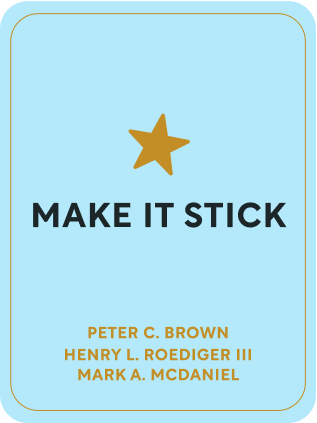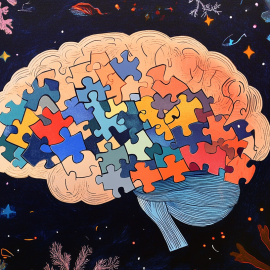

This article is an excerpt from the Shortform book guide to "Make It Stick" by Peter C. Brown, Henry L. Roediger III, Mark A. McDaniel. Shortform has the world's best summaries and analyses of books you should be reading.
Like this article? Sign up for a free trial here .
Can you increase your intelligence? Or is IQ fixed at birth? Is human IQ genetically predetermined or can it be improved?
Contrary to what many people think, your IQ isn’t predetermined. In fact, Americans’ average IQ has risen over time, likely because of changes in nutrition, schools, and culture.
Learn about the factors that affect your IQ and some strategies for improving your intelligence.
There Is More to IQ Than Your Genes
Several factors affect IQ scores, including:
- Genes
- Environment: A small genetic advantage can be multiplied in an environment that supports learning. For example, if two students are comparably intelligent but one is part of a family that has a home library and goes to a school that offers many types of classes and clubs, her learning will be nurtured and her intelligence will expand exponentially.
- Socioeconomic status: In more affluent families, the parents tend to have higher levels of education as well as jobs that give them more resources to support their children’s learning.
- Nutrition: Certain vitamins and nutrients support the brain’s health and boost its capacity for learning. Specifically, fatty acids aid nerve cell development and the formation of new synapses. Studies showed babies’ IQ scores were 3.5 to 6.5 points higher if they were exposed to fatty acid supplements directly or through their pregnant or breastfeeding mothers.
Given that non-genetic factors are implicated in IQ, you can increase your intelligence with lifestyle, practice, mindset, and the right tools.
Strategy #1: Growth Mindset
Grit and perseverance are far more important ingredients for success than intelligence. People who have a “growth mindset” are empowered to take their success into their own hands because they understand that effort and discipline are critical to their learning potential. These people work harder, take more risks, and view failures as learning opportunities.
On the other hand, people who have a “fixed mindset” have no sense of control over their own destinies because they believe that intelligence is the bottom-line determiner of success: They were either born with it or they weren’t. These people become helpless when they encounter failure because they attribute it to their lack of intelligence and ability.
Psychologist Carol Dweck studied this phenomenon and found several other characteristics associated with growth and fixed mindsets.
People with growth mindsets:
- Create learning goals, which focus on gaining information and skills. They set increasingly challenging goals in order to continually expand their knowledge.
- Tend to receive praise for their effort, which encourages them to continue to work hard and persevere.
People with fixed mindsets:
- Create performance goals, which focus on measurable achievements that validate their skills. They set more conservative goals to ensure they can achieve them and receive the validation they seek.
- Tend to receive praise for their intelligence, which discourages them from taking risks, for fear of blowing their image as an intelligent person.
(Shortform note: Read more about the growth mindset in our summary of Mindset, and about the value and the building blocks of grit in our summary of Grit.)
Strategy #2: Deliberate Practice
Mastery requires thousands of hours of deliberate practice. Deliberate practice is more than mere repetition—it has several distinct characteristics, including:
- Being solitary
- Being goal-oriented
- Pushing past current ability
(Shortform note: Read more about the power of deliberate practice in our summary of Peak.)
Pushing yourself, failing, troubleshooting, and trying again are necessary for building the skills and creating the mental models that lead to mastery. Through deliberate practice, you gradually develop a repertoire of increasingly high-level skills that you can then apply in a wide variety of situations.
Although deliberate practice is generally most effective when it’s solitary, coaches and trainers can play pivotal roles in helping you to see your areas of weakness, providing corrective feedback, and pushing you to redouble your efforts on the areas where you’re struggling most.
Strategy #3: Memory Cues
Memory cues are tools for shorthanding information that you need to remember. Memory cues can help you remember facts on a surface level, but they’re most valuable as a way of organizing and retaining information that you’ve already mastered. For example, you can use a mnemonic device to remember names and dates for a history test, but you won’t ace the test if you don’t understand the significance of those names and dates.
Mnemonic devices are tools that range from simple to complex to remember various types of information. For example, the acronym ROY G BIV is a mnemonic device for remembering the colors of the rainbow. In order for a mnemonic device to be useful, it needs to tether reminders to something very familiar, so that the things you need to remember are all tied to something nearly impossible to forget.
One type of mnemonic device that helps you recall larger amounts of information is a memory palace. Memory palaces capitalize on the idea that it’s easier to remember images than words.
To create a memory palace, follow these steps:
- Choose a physical space or route that you’re very familiar with, such as your home or your commute to work.
- Choose objects or features that stand out in that physical space, such as your couch or a major intersection.
- Make a mental link between each object and something you want to remember. For example, imagine yourself sitting on your couch with a friend who you need to remember to call.
When you need to recall the information, take a mental tour of the space. As you imagine yourself passing by each object, its associated reminder should pop up in your mind.
Another type of mnemonic device is a rhyme scheme, in which you create rhymes that associate your reminders with concrete images.
An example of a rhyme scheme is the peg method, which is a memory aid for lists of items. The peg method assigns an image to each number, from 1 to 20; the images always remain the same, no matter what you need to remember. Then you associate a reminder with each image. Say you assign “shoe” to 2, and you associate shoe with a reminder to go for a run.

———End of Preview———
Like what you just read? Read the rest of the world's best book summary and analysis of Peter C. Brown, Henry L. Roediger III, Mark A. McDaniel's "Make It Stick" at Shortform .
Here's what you'll find in our full Make It Stick summary :
- How to understand and remember what you learn
- How a little forgetting helps you remember
- Why you’re not a good judge of how much you know






